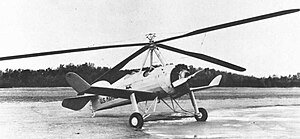| Pitcairn OP | |
|---|---|
| OP-1 under evaluation by the US Marine Corps | |
| Role | Reconnaissance autogyro |
| Manufacturer | Pitcairn-Cierva Autogiro Company |
| Introduction | 1932 |
| Status | Retired |
| Primary user | United States |
| Number built | 3 |
| Variants | Pitcairn PCA-2 |
The Pitcairn OP (manufacturer designation: PCA-2) was the first rotary-wing aircraft to be seriously evaluated by any of the world's major air forces. The machine was not a helicopter, nor an airplane, but an autogyro. Pitcairn's model was never put into production for any military.
Development[]
The Pitcairn-Cierva Autogiro Company, established by Harold Frederick Pitcairn, designed the PCA-2 based on the autogiros of Juan de la Cierva. The resulting design had a standard aircraft fuselage and powerplant, with a standard tail. However, it sported short, stubby wings, angled up at the wingtips. Above the cockpit was the rotor, consisting of three blades. The engine usually drove a standard propellor, on a vertical plane, in front of the aircraft. However, the engine could be geared to the horizontal rotor during takeoff or landing. The horizontal rotor, while in flight, did not draw energy from the engine but rather generated lift from airspeed. A minimum speed of 30 mph was needed to keep the aircraft in flight. Thus, in moderate winds, the aircraft could behave like a helicopter, except that it could not hover.
The Pitcairn autogyro was first evaluated by the US military in the 1930s. In 1931, the Navy tested three prototypes, labelled XOP-1. One was tested with the aircraft carrier USS Langley, on September 23, 1931. The only Pitcairn to see operational service did so in Nicaragua with the US Marines, starting in June 1932. This stint led to the Pitcairn OP-1 being rejected.[1]
In 1935, the wings were removed from one Pitcairn autogyro, and the resulting aircraft was redesignated OP-2.
Operational service[]
Only the Pitcairn OP-1 saw operational service. One autogyro, assigned to Marine Utility Squadron Six (VJ-6M), was sent to Nicaragua in June 1932. The autogyro would be tested through policing the rebel-infested mountains and jungles. While the aircraft performed well, its range significantly impaired it. In addition, after the crew only 50 pounds could be carried. Marine historian Robert Debs Heinl, Jr. recounted the autogyro as being an "exasperating contraption".
Operators[]
Specifications[]
Data from {name of first source}
General characteristics
- Crew: 2 (pilot and passenger)
- Length: 23 ft 1 in (7 m)
- Rotor diameter: 30 ft 3 in (9.1 m)
- Height: ()
- Loaded weight: 3,057 lb (1,386 kg)
- Powerplant: 1 × Wright R-975-E radial piston, 420 hp (313 kW)
Performance
- Maximum speed: 100 knots (115 mph, 185 km/h)
References[]
| Wikimedia Commons has media related to Pitcairn autogiros. |
- ↑ Norman Polmar. Historic naval aircraft: from the pages of Naval history magazine.
- Polmar, Norman and Dana Bell. One Hundred Years of World Military Aircraft.. Annapolis, Maryland: Naval Institute Press, 2004. ISBN 1-59114-686-0.
| |||||||||||||||||||||||||||||||||||||||||||||||||||||||||||||||||||||
The original article can be found at Pitcairn OP and the edit history here.
